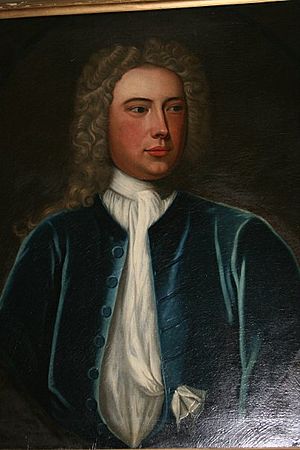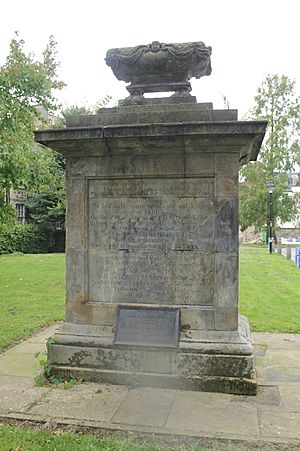Sir Robert Munro, 6th Baronet facts for kids
Quick facts for kids
Sir Robert Munro, Bt
|
|
|---|---|
 |
|
| Born | 1684 |
| Died | 1746 Falkirk |
| Buried | |
| Allegiance | British |
| Service/ |
British Army |
| Rank | Colonel |
| Unit | 43rd Highlanders later the 37th Regiment of Foot |
| Battles/wars | Siege of Inverness (1715) Siege of Brahan Battle of Fontenoy Battle of Falkirk Muir |
| Relations | Sir John Munro, 4th Baronet (grandfather) Sir Robert Munro, 5th Baronet (father) George Munro, 1st of Culcairn (brother) Sir Harry Munro, 7th Baronet (son) |
| Other work | Member of Parliament |
Sir Robert Munro, 6th Baronet (born August 24, 1684 – died January 17, 1746) was a Scottish military leader and politician. He lived in the 1700s, a time of big changes in Britain. He strongly supported the new royal family, the House of Hanover, and the way the country was governed.
He fought against the Jacobites, who wanted to bring back the old royal family, the House of Stuart. These Jacobites tried to regain power through fighting or political tricks. Sir Robert Munro was killed in battle at Falkirk Muir in 1746.
Contents
Early Life and Army Career
Robert was a child when King James VII and II lost his throne. This led to his daughter Mary II and her husband William III becoming rulers. This change secured a Protestant line of kings and queens for Britain.
When Robert was a young man, many Scots fought in Europe. They served under leaders like John Churchill, 1st Duke of Marlborough. This was during the War of the Spanish Succession.
Robert came from a family of leaders. His grandfather, Sir John Munro, 4th Baronet, and father, Sir Robert Munro, 5th Baronet, were chiefs of Clan Munro. Many of his relatives also served in the army. So, it was natural for young Robert to want an army career.
He got his first army job around 1710. He became a Captain in the Royal Scots regiment. He served for seven years in a place called Flanders. People said he did a great job there. When the war ended in 1712, he returned to Scotland.
Becoming a Member of Parliament
After returning to Scotland, Robert received some family land. He also became a member of the Parliament of Great Britain. This meant he helped make laws for the country. He represented the area of Tain Burghs for 31 years.
Robert was a Whig. Whigs supported the new Hanoverian kings. He often spoke out against the Tory party, who sometimes wanted to bring back the old royal family.
When King George I of Great Britain came to the throne in 1714, Robert became more important in politics. He shared news from Scotland with important leaders like Robert Walpole. He also helped keep peace in the northern Scottish Highlands. He commanded one of three special "Independent Companies" that policed the area. These companies wore traditional Highland clothes instead of regular army uniforms.
Fighting in Jacobite Rebellions
In 1715, a big rebellion started. This was the Jacobite rising of 1715. The Jacobites wanted to put the old royal family back on the throne. John Erskine, Earl of Mar led this uprising.
In the north, clans like Sutherland, Mackay, Ross, and Munro supported the government. But others, like the Mackenzies and Macdonalds, were Jacobites. Robert's brother, George Munro, 1st of Culcairn, prepared their clan for battle.
The Jacobites took control of Inverness. Robert Munro and his clan tried to stop them. They gathered forces at Alness. But the Jacobite army was much bigger. The Munros' land was taken over and robbed.
Later, Robert Munro helped take Inverness back from the Jacobites. He became the governor of the town. He even tried to help some of the defeated Jacobite leaders and their families. In 1719, Robert's younger brother, George, also helped defeat the Jacobites at the Battle of Glenshiel.
Leading the Clan and Planting Trees
After his father died in 1729, Colonel Robert became the chief of the Munro clan. He was the sixth Baronet of Foulis. As a landowner, he started planting many trees. He added almost 500 acres of woodlands to his estate.
He was also an elder in the Church of Scotland. He helped manage money to support preachers and teachers in the Highlands and Islands. People described Sir Robert as a kind and fair gentleman. He got along well with his neighbors.
In 1716, he married Mary Seymour from England. They had several children. Their oldest son, Harry, went to good schools. Another son joined the Royal Navy.
Lieutenant-Colonel of the 43rd Highlanders
Sir Robert returned to the British Army. In 1739, the Independent Companies he once commanded were made into a regular regiment. This was the famous 43rd Highlanders, also known as the Black Watch.
King George II of Great Britain himself approved their uniform. It included a kilt of dark green tartan and a blue hat. Sir Robert Munro was the lieutenant-colonel, meaning he was in charge of training the new regiment. His brother George was one of the captains.
In 1743, the regiment was ordered to London. Some soldiers thought they would not have to fight abroad. When they heard rumors they might be sent to America, about 200 men tried to go home. They were stopped, and some were punished. But the regiment soon became known for its excellent service.
Highlanders Meet the King
King George II had never seen a Highland soldier. So, he asked to meet some. Sir Robert Munro brought two soldiers, Gregor MacGregor and John Campbell, to London.
They showed the King how they used their weapons. They were very skilled with the broadsword and the Lochaber axe. The King was very impressed by their abilities.
Fighting in France
The regiment soon went to Flanders to fight in a war against France. They were praised for being very well-behaved towards the local people. They were often chosen to guard property.
Their first big battle against the French was on May 11, 1745, at Fontenoy. The British army was defeated. But the Highlanders fought bravely. They helped save the army from a complete disaster. Sir Robert told his men to lie down when the French fired. Then they would jump up and charge. They drove the enemy back many times.
The Last Jacobite Rebellion and Death
In June 1745, Sir Robert was given a new job. He became the Colonel of the English 37th (North Hampshire) Regiment of Foot. Soon after, the Jacobite rising of 1745 began. His friends hoped he would come back to the Highlands to help.
Robert's new regiment was sent to Scotland. They arrived in Edinburgh in January. They marched out to fight the Jacobites at the Battle of Falkirk Muir. It was a stormy day with rain and hail.
During the battle, Sir Robert was attacked by six Jacobite soldiers. He fought bravely with his half-pike and killed two of them. But another soldier shot him with a pistol and then struck him with a sword. Robert's unarmed brother, Dr. Duncan Munro, ran to help him but was also killed.
Sir Robert Munro was buried with honor in Falkirk churchyard. Even some of the Jacobite leaders attended his burial.
Legacy
A monument was later built for Sir Robert Munro in Falkirk churchyard. It has fancy decorations and words in Latin and English. The monument reminds people of him. It says he was "sincere and active in the service of his friends, humane and forgiving to his enemies, generous and benevolent to all." It also says that "his death was universally regretted even by those who slew him."
Family
Sir Robert Munro, 6th Baronet, married Mary Seymour. They had four children:
- Robert Munro, who died when he was a baby.
- Sir Harry Munro, 7th Baronet, who became the next Baronet.
- George Munro, who was an officer in the Royal Navy. He never married and died in 1743.
- Elizabeth Munro, who died when she was a baby.
See also
- Munro baronets


